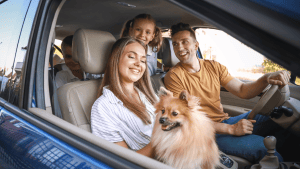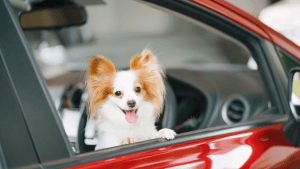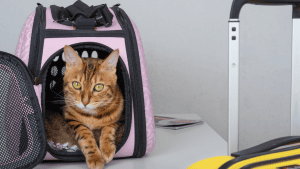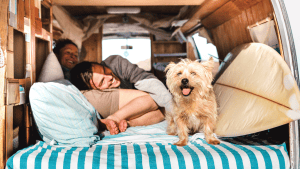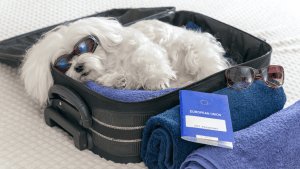Contents
- 9 Best Tips For Traveling With Pets
- 1. Plan Ahead: Pet-Friendly Accommodations
- 2. Research Pet-Friendly Destinations
- 3. Check Pet Policies
- 4. Prepare for the Journey: Visit the Vet
- 5. Pack Pet Essentials
- 6. Familiarize Your Pet with the Carrier
- 7. Traveling by Car: Safety Measures
- 8. Take Regular Breaks and Exercise
- 9. Flying with Your Pet: Airline Considerations
- 10. Requirements and Preparing Your Pet for Air Travel
- 11. Exploring Your Destination: Pet-Friendly Activities
- 12. Adapting to New Surroundings
- 13. Safety and Health Considerations
- 14. Social Etiquette and Responsible Travel
- Tips for traveling with a dog in a car
- Best way to travel with a dog in a car
- The cheapest way to travel with a dog
- Is it safe for dogs to fly in cargo
- How to travel with a dog internationally
- Conclusion
9 Best Tips For Traveling With Pets
Tips for traveling with pets…
Traveling with your beloved pet can be an incredibly rewarding and memorable experience.
Whether you’re embarking on a road trip or jetting off to a new destination, taking your furry friend along requires some extra planning and preparation.
In this article, we’ll explore nine tips for traveling with pets to ensure a smooth and enjoyable journey for both you and your pet.
1. Plan Ahead: Pet-Friendly Accommodations
This is one of the pro tips for traveling with pets…
When traveling with your pet, it’s crucial to research and book pet-friendly accommodations in advance.
Look for hotels, vacation rentals, or campgrounds that warmly welcome pets and provide suitable amenities to ensure a comfortable stay for your furry companion.
2. Research Pet-Friendly Destinations
Choosing the right destination is key when traveling with pets.
Look for places known for their pet-friendly atmospheres…
Such as cities with ample parks, hiking trails, and outdoor activities where your pet can roam and explore alongside you.
3. Check Pet Policies
This is another one of the pro tips for traveling with pets…
Before finalizing your travel plans, take the time to thoroughly check the pet policies of airlines, hotels, and any other establishments you’ll be visiting.
Ensure that their guidelines align with your pet’s needs and requirements, so there are no surprises during your trip.
4. Prepare for the Journey: Visit the Vet
A visit to the veterinarian before your trip is essential.
Make sure your pet is up to date on vaccinations and obtain a health certificate if required.
Take this opportunity to discuss any concerns or specific considerations with your vet to ensure your pet’s well-being throughout the journey.
5. Pack Pet Essentials
This is another one of the pro tips for traveling with pets…
When packing for your trip, don’t forget to include all the necessary essentials for your pet.
This includes food, water, bowls, medications, toys, a leash, a collar with identification tags, waste bags, and bedding.
Familiar scents and favorite toys can provide comfort and a sense of home for your pet during the journey.
6. Familiarize Your Pet with the Carrier
If traveling by car or air, it’s important to introduce your pet to their carrier or crate before the trip.
Gradually acclimate them to the carrier by associating positive experiences with it, such as treats or short periods of playtime inside.
This will help reduce their anxiety and make them more comfortable during travel.
7. Traveling by Car: Safety Measures
This is another one of the pro tips for traveling with pets…
When traveling by car, ensure your pet’s safety by using a secured pet restraint system or a well-ventilated crate.
Allow your pet to ride in the backseat, and avoid the temptation to let them roam freely in the car, as it can be dangerous for both of you.
8. Take Regular Breaks and Exercise
During long car journeys, plan regular breaks to allow your pet to stretch their legs, relieve themselves, and stay hydrated.
Research pet-friendly rest stops or parks along your route, providing opportunities for exercise and mental stimulation for your furry companion.
9. Flying with Your Pet: Airline Considerations
This is also one of the pro tips for traveling with pets…
If you’re flying with your pet, research different airlines and their pet policies.
Some airlines have restrictions based on pet size, breed, or specific routes.
Choose an airline that accommodates your pet’s needs and provides a comfortable travel experience for both of you.
whether you’re flying with a large dog or traveling with a pet of any size, prioritizing your pet’s well-being is essential.
By following these travel safety tips and pet travel tips, you can ensure a smoother experience while traveling with your dog.
Remember to research airline policies, prepare necessary documents, provide comfort items, and consider calming techniques to make the journey more comfortable for your furry companion.
10. Requirements and Preparing Your Pet for Air Travel
Familiarize yourself with the specific requirements and regulations for flying with pets.
This includes obtaining the necessary health certificates, ensuring your pet’s vaccinations are up to date, and adhering to any size and weight restrictions for carriers.
Additionally, help your pet adjust to the carrier by gradually introducing them to it before the trip and providing familiar scents and comforts.
11. Exploring Your Destination: Pet-Friendly Activities
This is another one of the pro tips for traveling with pets…
Make the most of your destination by researching pet-friendly activities and places to visit. Look for parks, trails, and attractions that welcome pets.
This could include pet-friendly beaches, hiking trails, or outdoor cafes where you and your furry friend can enjoy quality time together.
12. Adapting to New Surroundings
Once you arrive at your destination, give your pet some time to adjust to the new surroundings.
Keep their routines as consistent as possible, provide them with familiar items from home, and gradually introduce them to new experiences and environments.
This will help them feel more at ease and comfortable during your travels.
13. Safety and Health Considerations
This is another one of the pro tips for traveling with pets…
Ensure your pet’s safety and well-being by taking necessary precautions.
Make sure your pet has proper identification tags with your contact information, and consider getting them microchipped for added security.
Research local veterinary clinics and emergency services at your destination, so you know where to go in case of any health concerns or emergencies.
14. Social Etiquette and Responsible Travel
While traveling with your pet, it’s important to be mindful of others and practice responsible pet ownership.
Always clean up after your pet and dispose of waste properly.
Respect any rules or regulations regarding leashing your pet and be considerate of fellow travelers who may not be as comfortable around animals.
Tips for traveling with a dog in a car
This portion is about tips for traveling with pets particularly dog.
Traveling with a dog in a car can be an enjoyable experience with proper preparation and safety measures in place.
Here are some tips to make your journey smooth and comfortable for both you and your furry friend:
- Prepare your dog: Before the trip, ensure your dog is comfortable being in a car by taking them on short drives. Gradually increase the duration to help them acclimate to the car environment.
- Secure your dog: Use a crate, carrier, or a dog seat belt/harness to secure your dog while traveling. This prevents them from roaming around the car, causing distractions, or getting injured during sudden stops.
- Take breaks: Plan for regular breaks to allow your dog to stretch their legs, relieve themselves, and stay hydrated. Aim for breaks every 2-3 hours, and never leave your dog alone in the car, especially in hot weather.
- Pack essentials: Bring your dog’s favorite toys, blanket, and bedding to provide them with familiar scents and comforts during the journey. Pack enough food, treats, water, and bowls for your dog’s needs.
- ID tags and microchips: Ensure your dog is wearing a collar with identification tags containing up-to-date contact information. Additionally, consider microchipping your dog as a precautionary measure.
- Medications and records: If your dog requires any medications, carry an adequate supply for the trip. Take along their medical records and vaccination certificates in case of emergencies or unexpected situations.
- Practice restraint: It’s important to keep your dog’s head and paws inside the car at all times. Avoid allowing them to stick their head out of the window, as this can be dangerous and cause injury.
- Gradual feeding: Feed your dog a light meal a few hours before the journey to avoid motion sickness. Avoid feeding them a large meal right before the trip, as it can lead to discomfort.
- Comfort and temperature control: Ensure the car is well-ventilated and at a comfortable temperature for your dog. Avoid exposing them to extreme heat or cold. Never leave your dog unattended in a hot car, even with the windows cracked.
- Familiarize with the route: If it’s your dog’s first time traveling a long distance, try to familiarize them with the car and the route by taking them on shorter trips before embarking on a long journey.
Remember to consult with your veterinarian for any specific concerns or advice tailored to your dog’s needs. Enjoy your trip and make lasting memories with your furry travel companion!
Best way to travel with a dog in a car
The great way to travel with a dog in a car depends on various factors, including your dog’s size, temperament, and length of the journey.
Here are some general recommendations for a safe and comfortable trip:
- Use a secure crate or carrier: A crate or carrier provides a safe and confined space for your dog during the journey. It prevents them from roaming around the car, causing distractions, or getting injured. Make sure the crate is well-ventilated and large enough for your dog to stand, turn around, and lie down comfortably.
- Secure them with a harness or seat belt: If your dog is not comfortable in a crate, consider using a dog-specific seat belt or harness that attaches to the car’s seat belt system. This keeps them restrained and prevents them from moving around the vehicle.
- Gradually acclimate your dog: Help your dog get used to the car by taking them on short drives around the neighborhood. Gradually increase the duration and distance of the trips, using positive reinforcement techniques and treats to create positive associations with car travel.
- Keep them comfortable: Line the crate or carrier with bedding or a familiar blanket to make it cozy for your dog. If using a seat belt or harness, ensure it fits properly and does not cause discomfort or restriction.
- Plan regular breaks: Dogs need regular breaks to stretch their legs, relieve themselves, and have a drink of water. Schedule breaks every 2-3 hours to give your dog a chance to move around and take care of their needs.
- Pack essential supplies: Bring enough food, treats, water, and bowls for your dog’s journey. It’s also helpful to pack waste bags, cleaning supplies, and any necessary medications.
- Keep your dog hydrated: Offer water to your dog during breaks to keep them hydrated. Use spill-proof water bowls or a water bottle with a built-in dispenser to prevent messes in the car.
- Avoid feeding right before travel: Feeding your dog a light meal a few hours before the trip can help prevent motion sickness. Avoid feeding them a large meal right before the journey to minimize discomfort.
- Secure identification and records: Ensure your dog is wearing a collar with identification tags containing up-to-date contact information. It’s also a good idea to carry your dog’s medical records and vaccination certificates in case of emergencies.
- Never leave your dog unattended: Never leave your dog alone in the car, especially in hot weather. Even with the windows cracked, temperatures can rise dangerously, leading to heatstroke or other health issues.
Remember to tailor these tips to your dog’s specific needs and consult with your veterinarian for any additional advice. Happy travels with your furry companion!
The cheapest way to travel with a dog
Here are tips for the cheaper ways to travel with a dog:
- Opt for road trips instead of flying or taking trains or buses.
- Research budget-friendly accommodations that allow dogs.
- Consider camping as an affordable option for both you and your dog.
- Check public transportation pet policies for any available options.
- Pack essential items like food, water, bedding, and toys.
- Plan your trip in advance to take advantage of discounts and promotions.
- Utilize online resources to find pet-friendly travel options.
Remember to prioritize your dog’s comfort, safety, and well-being throughout the journey.
Is it safe for dogs to fly in cargo
The safety of dogs flying in cargo depends on several factors, including the airline’s policies, the dog’s health and breed, and the specific conditions of the flight.
While many dogs do travel safely in cargo, there are risks involved that you should consider.
Here are some factors to keep in mind:
- Check the airline’s policies on pet transportation in cargo.
- Consult with your veterinarian to ensure your dog is fit for travel.
- Be aware of temperature extremes in the cargo hold.
- Use a sturdy and well-ventilated crate that meets airline requirements.
- Consider your dog’s stress and anxiety levels during air travel.
- Inquire about the airline’s handling and care procedures for pets.
To make an informed decision about whether it’s safe for your dog to fly in cargo, consider discussing your specific situation with your veterinarian and researching the airline’s pet transportation policies thoroughly.
Alternatives such as traveling with your dog in the cabin or exploring ground transportation options may also be worth considering, depending on your circumstances.
How to travel with a dog internationally
Here are steps to travel internationally with a dog:
- Research import requirements of the destination country.
- Schedule a veterinary visit for health check-ups and vaccinations.
- Microchip your dog as per international standards.
- Obtain required travel documents and certificates.
Remember to start the planning process well in advance to allow enough time for completing all the necessary steps and ensure a smooth journey for your dog.
Conclusion
Traveling with pets can be an incredibly rewarding experience that strengthens the bond between you and your furry companion.
By following these nine best tips for traveling with pets, you can ensure a safe, enjoyable, and stress-free journey for both you and your pet.
Remember to plan ahead, prioritize your pet’s comfort and well-being, and be a responsible and considerate pet owner throughout your travels.
Frequently Asked Questions (FAQs)
Q: Can I bring my pet on all airlines? A: Each airline has its own policies regarding pet travel. While many airlines do allow pets, some may have restrictions based on size, breed, or specific routes. It's important to research and check with the airline in advance to ensure your pet can accompany you on your desired flight. Q: How can I keep my pet calm during the journey? A: Keeping your pet calm during travel can be achieved by creating a comfortable and familiar environment. Consider using calming aids, such as pheromone sprays or natural remedies recommended by your veterinarian. Additionally, bringing familiar items like their favorite blanket or toy can provide a sense of security and help keep them calm. Q: Should I feed my pet before traveling? A: It's generally recommended to avoid feeding your pet a large meal before traveling, especially if you'll be flying. This can help prevent motion sickness or discomfort during the journey. However, do provide small amounts of water to keep your pet hydrated. Q: What should I do if my pet gets anxious during travel? A: If your pet gets anxious during travel, there are several techniques you can try. Create a calming environment by playing soothing music or using a soft, familiar-smelling blanket. Consult with your veterinarian about possible anxiety-relief medications or natural remedies to help your pet feel more relaxed. Q: Are there any pet-friendly accommodations that provide special amenities? A: Yes, many pet-friendly accommodations offer special amenities for pets. These may include pet beds, food bowls, and even treats. Some establishments may also have designated pet play areas or walking trails. When booking your accommodations, inquire about these amenities to ensure a comfortable stay for your pet. Q: What should I do if my pet falls ill during the trip? A: If your pet falls ill during the trip, it's important to seek veterinary care as soon as possible. Research local veterinary clinics or emergency services in the area you're visiting beforehand, so you know where to go in case of an emergency. Carry your pet's medical records and any necessary medications. Q. How do you travel long distances with pets? Plan your route and make frequent stops for bathroom breaks and exercise. Ensure your pet is secure in a well-ventilated crate or carrier. Keep your pet hydrated and provide regular meals. Make sure your pet has proper identification tags and updated microchip information. Consider bringing comfort items, such as familiar bedding or toys, to reduce anxiety. Q. What should you bring with you when traveling with pets? Sufficient food, treats, and portable water bowls. Medications, if applicable, along with copies of prescriptions. Vaccination records and health certificates. Leashes, harnesses, and poop bags for outdoor walks. Comfort items, such as bedding, toys, and familiar scents. A pet first-aid kit. Contact information for emergency veterinary care at your destination. Q. How do you carry pets while traveling? Use a secure and well-ventilated crate or carrier that meets airline or transportation regulations. Ensure the crate or carrier is the appropriate size for your pet, allowing them to stand, turn around, and lie down comfortably. Place absorbent bedding and familiar items inside the crate for comfort. Use a leash or harness when outside the crate to keep your pet secure. Follow airline or transportation guidelines for check-in and handling procedures. Q. How do I calm my pet for travel? Familiarize your pet with the crate or carrier well in advance of travel. Use positive reinforcement and rewards to create a positive association with the crate. Consider using calming aids, such as pheromone sprays, anxiety wraps, or natural supplements (under veterinary guidance). Play soothing music or use white noise to create a calming environment. Consult with your veterinarian about the possibility of prescribing anti-anxiety medication if necessary.


